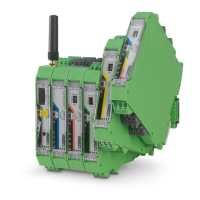RAD-...-IFS
128 / 198
PHOENIX CONTACT 105542_en_05
Frequency hopping spread spectrum (FHSS) method
Trusted Wireless 2.0 uses the frequency hopping spread spectrum (FHSS) method. In the
2.4 GHz frequency band, a selection of up to 127 channels from the entire spectrum of the
frequency band is used. In the 868 MHz frequency band, up to 14 channels are available.
The wireless module “hops” between these channels on the basis of a pseudo-random pat-
tern. This results in more robust and more reliable communication.
RF bands
Trusted Wireless 2.0 can be operated on different RF (radio frequency) bands. This enables
the simultaneous use of several Trusted Wireless 2.0 systems.
Coexistence management (for 2.4 GHz only)
Blacklisting means that certain frequencies can be hidden selectively. For example, this
method allows you to operate several WLAN systems in parallel with Trusted Wireless 2.0
systems without any performance limitations.
Data encryption and authentication
Trusted Wireless 2.0 is a proprietary technology. The protocol has not been published.
Therefore it is better protected against attacks. In addition, two security mechanisms have
been implemented with 128-bit AES data encryption and authentication. Data encryption
makes sure that intercepted data packets are not “understood”. The authentication process
checks the sender’s authenticity. For this, a continuous code is added to the message,
which must not be repeated. A message that has been tampered with will be recognized as
not valid and discarded.
Range
Distances up to several kilometers can be covered with Trusted Wireless 2.0. You can set
the data rate of the wireless interface and adapt it to the relevant application. You can in-
crease the sensitivity of the receiver and therefore the range by reducing the data rate.
The relationship between range and data rate can be illustrated by the energy per bit trans-
mitted. The higher the energy per bit, the greater the achievable range. The energy per bit
results from the ratio between transmission power and data rate:
energy per bit = transmission power / data rate

